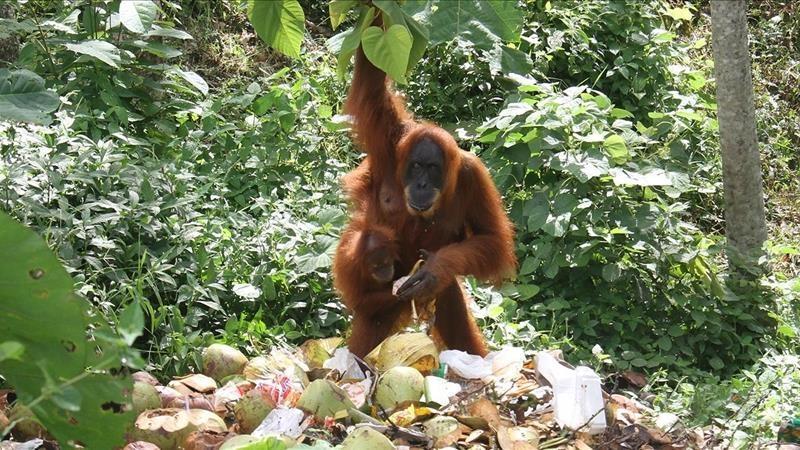*Writing by Gizem Nisa Cebi in Istanbul
Africa-Press – Tanzania. A study in China found that Gigantopithecus, a giant primate that went extinct 215,000 to 295,000 years ago, failed to adapt to environmental changes caused by climate change, resulting in its disappearance from the Earth.
The study that was published in the journal Nature delves into the extinction of Gigantopithecus, also known as Gigantopithecus blacki, despite cyptozoologists’ claims that it might live on as the famed Bigfoot or Himalayan Yeti — the largest primate in history and a member of the Asian monkey family.
Alper Yener Yavuz, an anthropologist at Türkiye’s Burdur Mehmet Akif Ersoy University, shared insights with Anadolu about how researchers, seeking to shed light on the big animal’s extinction, worked in 22 caves in South China.
They discovered that Gigantopithecus, a primate towering around 2.5 – 3 meters (8 – 10 feet) tall and weighing 350 – 400 kilograms (440 – 660 pounds), became extinct due to population declines attributed to alterations in habitat and dietary preferences along with seasonal variations.
Yavuz clarified that the earliest discoveries related to the Gigantopithecus date to the 1910s, and research initiated during that period concluded with the study that was completed in early 2024. Gigantopithecus inhabited a timeframe ranging from 2 million to 200,000 years ago and gained research prominence with the discovery of primate teeth in China in 1935.
Recent investigations involved a thorough examination of dental, jaw and other body parts found in caves in China, as well as other faunal remains.
An ages-old era of ‘serious climate change’
Yavuz stressed that when a species encounters a shortage of food and struggles to locate a suitable habitat, it is compelled to migrate, undergo alterations or face extinction.
“At that period, a very serious climate change occurred, recognized as the last ice age. The crucial point here is not merely freezing to death due to extremely cold weather; this circumstance impacts not only animals but also plants, flora, and the entire ecosystem. We observe that Gigantopithecus couldn’t adapt to the evolving climate and flora. The study also suggests that species in the changing animal fauna went extinct as they couldn’t compete with other animals consuming the same food,” he said.
Yavuz stressed that changes in environmental factors due to climate change compelled Gigantopithecus, which primarily consumed plant-based sources such as fruits, fruit seeds, and cones, to shift to an entirely different dietary preference. He said even though the primate could access essential nutrients, changes in secondary nutrients resulted in food-related issues.
Emphasizing that the study’s foundation relied on all jaw pieces discovered in the caves in China, Yavuz noted that the analysis of 2,000 teeth provided evidence that Gigantopithecus fed on items such as shell fruits, fruit seeds or cones.
Seasonal environmental changes led to extinction
Murat Turkes, a physical geographer who sits on the board of the Center for Climate Change and Policies Application and Research at Istanbul’s Bogazici University, explained that the shift from the Pliocene period, spanning 7 to 2.6 million years ago, to the Quaternary period in the last 2.6 million years, was initially marked by warm conditions followed by colder ones.
Turkes said the period in which Gigantopithecus lived aligns with the early-mid Pleistocene, providing details about notable consecutive glacial and interglacial periods occurring during the mid-late stages of the Pleistocene era.
Highlighting the decrease in temperatures, reduction in sea levels and the transformation of a significant portion of atmospheric precipitation into permanent snow and ice at the onset of the glacial age, he added: “We can see that the lineage of Gigantopithecus gradually disappeared due to environmental changes. The era leading to the extinction of this primate species is predominantly linked to the glacial age and comparatively cold conditions. While there is an influence of a relatively cold glacial age until the period between 295,000 and 215,000 years ago, there is a subsequent warming during the extinction process.”
Turkes clarified that the shift from a climate with lower seasonality throughout the year to a period with higher seasonality led to environmental changes, converting dense forests into open forests with lower density, along with the emergence of shrubs and grasslands.
He also highlighted that the substantial alteration in vegetation compelled the herbivorous Gigantopithecus to exert more effort in searching for food.
“The primary factors involve the reduction and scarcity of food, leading to heightened threats, diminished immunity, and a decline in reproductive success. It’s possible that primates were impacted by diseases and pests, which surged alongside environmental changes. The rising variability in climate and the heightened seasonality causing alterations in ecosystems serve as evidence of profound shifts in natural vegetation,” he said.
According to Turkes, based on the study, it is believed that several species closely related to Gigantopithecus were able to adjust their dietary preferences and behaviors in response to changing conditions. But the large primate failed to adapt to the changing climate, vegetation, environment and conditions related to food and access to food. As a result, it exhibited signs of chronic stress and a diminishing population, ultimately leading to its extinction.
For More News And Analysis About Tanzania Follow Africa-Press







